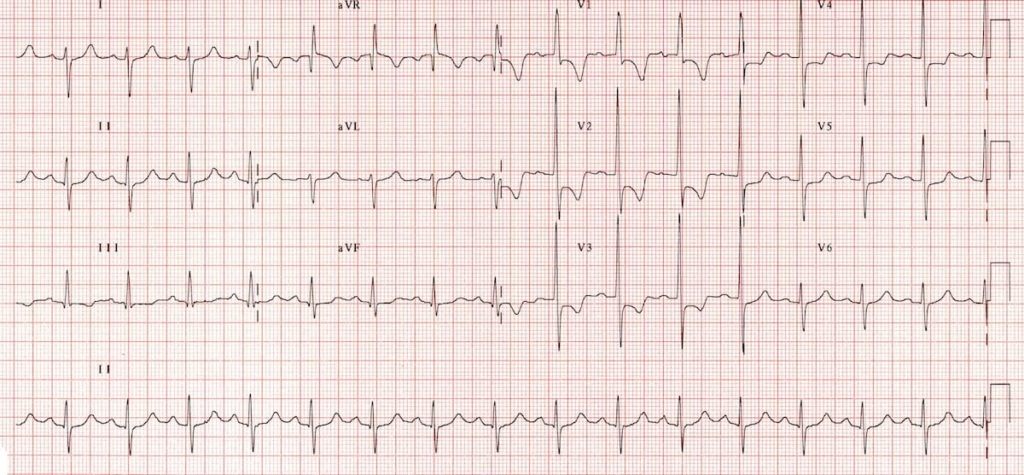Right Ventricular Hypertrophy (RVH)
Electrocardiographic Features
Diagnostic criteria
- Right axis deviation of +110° or more.
- Dominant R wave in V1 (> 7mm tall or R/S ratio > 1).
- Dominant S wave in V5 or V6 (> 7mm deep or R/S ratio < 1).
- QRS duration < 120ms (i.e. changes not due to RBBB).
Supporting criteria
- Right atrial enlargement (P pulmonale).
- Right ventricular strain pattern = ST depression / T wave inversion in the right precordial (V1-4) and inferior (II, III, aVF) leads.
- S1 S2 S3 pattern = far right axis deviation with dominant S waves in leads I, II and III.
- Deep S waves in the lateral leads (I, aVL, V5-V6).
Other abnormalities caused by RVH
- Right bundle branch block (complete or incomplete).
ECG Pearl
There are no universally accepted criteria for diagnosing RVH in the presence of RBBB; the standard voltage criteria do not apply.
However, the presence of incomplete / complete RBBB with a tall R wave in V1, right axis deviation of +110° or more and supporting criteria (such as RV strain pattern or P pulmonale) would be considered suggestive of RVH.
Causes
- Pulmonary hypertension
- Mitral stenosis
- Pulmonary embolism
- Chronic lung disease (cor pulmonale)
- Congenital heart disease (e.g. Tetralogy of Fallot, pulmonary stenosis)
- Arrhythmogenic right ventricular cardiomyopathy
ECG Examples
Example 1

Typical appearance of RVH:
- Right axis deviation (+150 degrees).
- Dominant R wave in V1 (> 7 mm tall; R/S ratio > 1)
- Dominant S wave in V6 (> 7 mm deep; R/S ratio < 1).
- Right ventricular strain pattern with ST depression and T-wave inversion in V1-4.
Example 2

- Right axis deviation (+150 degrees)
- P pulmonale (P wave in lead II > 2.5 mm)
- Incomplete RBBB
- Right ventricular strain pattern with T-wave inversion and ST depression in the right precordial (V1-3) and inferior (II, III, aVF) leads.
This ECG was originally posted by Johnson Francis on Cardiophile.org.
Example 4

Right ventricular hypertrophy in a patient with arrhythmogenic right ventricular cardiomyopathy (ARVC):
- Right axis deviation.
- R/S ratio in V1 > 1
- Right ventricular strain pattern with T-wave inversion and ST depression in the right precordial (V1-3) and inferior (II, III, aVF) leads.
This ECG was originally posted by Jayachandran Thejus on the website HeartPearls.com.
Related Topics
- Right ventricular strain.
- The ECG in pulmonary embolism.
- The ECG in chronic lung disease.
- Left ventricular hypertrophy.
References
- Harrigan RA, Jones K. ABC of clinical electrocardiography. Conditions affecting the right side of the heart. BMJ. 2002 May 18;324(7347):1201-4. Review. PMID: 12016190
Advanced Reading
Online
- Wiesbauer F, Kühn P. ECG Mastery: Yellow Belt online course. Understand ECG basics. Medmastery
- Wiesbauer F, Kühn P. ECG Mastery: Blue Belt online course: Become an ECG expert. Medmastery
- Kühn P, Houghton A. ECG Mastery: Black Belt Workshop. Advanced ECG interpretation. Medmastery
- Rawshani A. Clinical ECG Interpretation ECG Waves
- Smith SW. Dr Smith’s ECG blog.
- Wiesbauer F. Little Black Book of ECG Secrets. Medmastery PDF
Textbooks
- Zimmerman FH. ECG Core Curriculum. 2023
- Mattu A, Berberian J, Brady WJ. Emergency ECGs: Case-Based Review and Interpretations, 2022
- Straus DG, Schocken DD. Marriott’s Practical Electrocardiography 13e, 2021
- Brady WJ, Lipinski MJ et al. Electrocardiogram in Clinical Medicine. 1e, 2020
- Mattu A, Tabas JA, Brady WJ. Electrocardiography in Emergency, Acute, and Critical Care. 2e, 2019
- Hampton J, Adlam D. The ECG Made Practical 7e, 2019
- Kühn P, Lang C, Wiesbauer F. ECG Mastery: The Simplest Way to Learn the ECG. 2015
- Grauer K. ECG Pocket Brain (Expanded) 6e, 2014
- Surawicz B, Knilans T. Chou’s Electrocardiography in Clinical Practice: Adult and Pediatric 6e, 2008
- Chan TC. ECG in Emergency Medicine and Acute Care 1e, 2004
LITFL Further Reading
- ECG Library Basics – Waves, Intervals, Segments and Clinical Interpretation
- ECG A to Z by diagnosis – ECG interpretation in clinical context
- ECG Exigency and Cardiovascular Curveball – ECG Clinical Cases
- 100 ECG Quiz – Self-assessment tool for examination practice
- ECG Reference SITES and BOOKS – the best of the rest
ECG LIBRARY
Emergency Physician in Prehospital and Retrieval Medicine in Sydney, Australia. He has a passion for ECG interpretation and medical education | ECG Library |
MBBS DDU (Emergency) CCPU. Adult/Paediatric Emergency Medicine Advanced Trainee in Melbourne, Australia. Special interests in diagnostic and procedural ultrasound, medical education, and ECG interpretation. Co-creator of the LITFL ECG Library. Twitter: @rob_buttner


in your last example, please notice diffuse epsilon waves in arvc